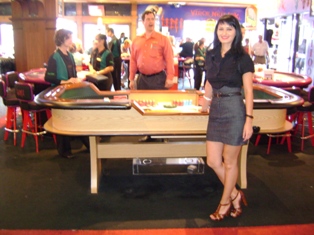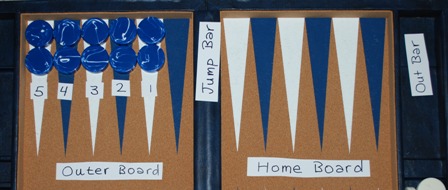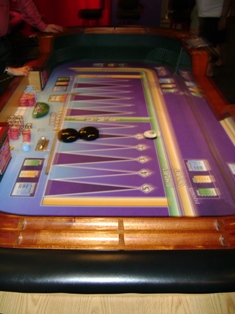On this page
Casino Backgammon
Introduction
Casino Backgammon is a table game, which made its Las Vegas debut at O'Sheas casino, I think in May 2010. It did not last long there. I asked dealers what happened to it and they said it didn't do well. The former official website for the game has also vanished, so I think your odds of finding this game out there are no longer very good.
The layout of the game looks like one side of a backgammon board. Two pieces are placed on the board and the object is to roll the dice and move them over the bar in one move, and off the board in two to three. The specific bets and rules are explained below.
Rules
Before going further, let me introduce some terminology.
- Home Board: The six points on the right of the Jump Bar.
- Jump Bar: The bar between the inner board and outer board. The goal of the first roll is to get both pieces over the Jump Bar.
- Points: The triangles the pieces move on.
- Out Bar: The bar on the other side of the outer board. The goal of the second/third roll is to get both pieces over the Out Bar.
- Outer Board: The six points on the left of the Jump Bar.
Three bets are available, as follows.
- Jump: This bet wins if both pieces are moved over the bar in one roll.
- Out: This bet wins if both pieces can be moved off the board in two rolls, or three rolls if either of the first two rolls are doubles.
- Doubles: Side wager on the number and type of doubles thrown.
Jump and Out bets must be equal.
Following are the specific rules.
- The game starts with two pieces on what the game calls "point 1," which is two points from the bar.
- Players make their wagers.
- Two dice are rolled by the designated shooter.
- Each piece is moved the number of points corresponding to the individual roll of the two dice. For example, if the shooter rolls a 4 and 5, then one piece would be moved 4 points while the other piece moves 5 points.
- If the player rolls doubles, then he moves each piece according to the roll of a each die. This is unlike conventional backgammon, where the player moves 2x the roll of each die. See rule 8 for more about doubles.
- The object of the first roll is to get both pieces over the Jump Bar. If successful, then the Jump bet will win.
- The shooter will roll the dice again.
- The piece with further to go will be moved the number of points of the larger die roll. The piece closer to being off the board will be moved the number of points of the smaller die roll. If both pieces make it over the Out Bar, then the Out bet will win.
- If the player rolls doubles in the first or second roll, he will be given a third roll if any pieces are still on the board or if any player made the Doubles bet.
- If either the last Jump or Out bet resulted in a win, and the shooter wishes to continue to roll, then rules 2 to 9 are repeated, except the pieces on "point 2" are the ones to move.
- If either the last Jump or Out bet resulted in a win, and the shooter wishes to continue to roll, then rules 2 to 9 are repeated, except the pieces on "point 3" are the ones to move.
- If either the last Jump or Out bet resulted in a win, and the shooter wishes to continue to roll, then rules 2 to 9 are repeated, except the pieces on "point 4" are the ones to move.
- If either the last Jump or Out bet resulted in a win, and the shooter wishes to continue to roll, then rules 2 to 9 are repeated, except the pieces on "point 5" are the ones to move.
- If after any Doubles bet the shooter chooses to not shoot any longer, then he may pass the dice. The next shooter will start with the pieces at "point 1."
Winning Jump and Out bets are paid according to the starting point, as follows.
Jump and Out Pay Table
| Point | Jump Bet | Out Bet |
|---|---|---|
| 1 | 3 to 5 | 1 to 1 |
| 2 | 2 to 1 | 1 to 1 |
| 3 | 3 to 1 | 4 to 1 |
| 4 | 10 to 1 | 5 to 1 |
| 5 | 40 to 1 | 9 to 1 |
The Doubles Wager pays according to the number of doubles per point. Following is the Doubles bet pay table.
Doubles Pay Table
| Event | Pays |
|---|---|
| Three doubles | 100 to 1 |
| Two equal doubles | 20 to 1 |
| Two non-equal doubles | 3 to 1 |
| All other | Loss |
Analysis
The following five tables show the analysis of the Jump bet at each starting point. Note that a positive return means a player advantage.
1-Point Jump Bet Return Table
| Outcome | Pays | Combinations | Probability | Return |
|---|---|---|---|---|
| Win | 0.6 | 25 | 0.694444 | 0.416667 |
| Lose | -1 | 11 | 0.305556 | -0.305556 |
| Total | 36 | 1.000000 | 0.111111 |
2-Point Jump Bet Return Table
| Outcome | Pays | Combinations | Probability | Return |
|---|---|---|---|---|
| Win | 2 | 16 | 0.444444 | 0.888889 |
| Lose | -1 | 20 | 0.555556 | -0.555556 |
| Total | 36 | 1.000000 | 0.333333 |
3-Point Jump Bet Return Table
| Outcome | Pays | Combinations | Probability | Return |
|---|---|---|---|---|
| Win | 3 | 9 | 0.250000 | 0.750000 |
| Lose | -1 | 27 | 0.750000 | -0.750000 |
| Total | 36 | 1.000000 | 0.000000 |
4-Point Jump Bet Return Table
| Outcome | Pays | Combinations | Probability | Return |
|---|---|---|---|---|
| Win | 10 | 4 | 0.111111 | 1.111111 |
| Lose | -1 | 32 | 0.888889 | -0.888889 |
| Total | 36 | 1.000000 | 0.222222 |
5-Point Jump Bet Return Table
| Outcome | Pays | Combinations | Probability | Return |
|---|---|---|---|---|
| Win | 40 | 1 | 0.027778 | 1.111111 |
| Lose | -1 | 35 | 0.972222 | -0.972222 |
| Total | 36 | 1.000000 | 0.138889 |
The following five tables show the analysis of the Out bet at each starting point.
1-Point Out Bet Return Table
| Outcome | Pays | Combinations | Probability | Return |
|---|---|---|---|---|
| Win | 1 | 18733 | 0.401513 | 0.401513 |
| Lose | -1 | 27923 | 0.598487 | -0.598487 |
| Total | 46656 | 1.000000 | -0.196974 |
2-Point Out Bet Return Table
| Outcome | Pays | Combinations | Probability | Return |
|---|---|---|---|---|
| Win | 1 | 12572 | 0.269462 | 0.269462 |
| Lose | -1 | 34084 | 0.730538 | -0.730538 |
| Total | 46656 | 1.000000 | -0.461077 |
3-Point Out Bet Return Table
| Outcome | Pays | Combinations | Probability | Return |
|---|---|---|---|---|
| Win | 4 | 8441 | 0.180920 | 0.723680 |
| Lose | -1 | 38215 | 0.819080 | -0.819080 |
| Total | 46656 | 1.000000 | -0.095400 |
4-Point Out Bet Return Table
| Outcome | Pays | Combinations | Probability | Return |
|---|---|---|---|---|
| Win | 5 | 5582 | 0.119642 | 0.598208 |
| Lose | -1 | 41074 | 0.880358 | -0.880358 |
| Total | 46656 | 1.000000 | -0.282150 |
5-Point Out Bet Return Table
| Outcome | Pays | Combinations | Probability | Return |
|---|---|---|---|---|
| Win | 9 | 3497 | 0.074953 | 0.674576 |
| Lose | -1 | 43159 | 0.925047 | -0.925047 |
| Total | 46656 | 1.000000 | -0.250472 |
The player must make equal bets on the Jump and Out bets. So, the relevant question is, what is the average return of the two bets? The following table summarizes the return for each bet for each point, as well as the average return.
Return Summary Table
| Point | Jump Return | Out Return | Average Return |
|---|---|---|---|
| 1 | 0.111111 | -0.196974 | -0.042931 |
| 2 | 0.333333 | -0.461077 | -0.063872 |
| 3 | 0.000000 | -0.095400 | -0.047700 |
| 4 | 0.222222 | -0.282150 | -0.029964 |
| 5 | 0.138889 | -0.250472 | -0.055791 |
The final table shows the possible outcomes and return for the Doubles bet.
Doubles Bet Return Table
| Outcome | Pays | Combinations | Probability | Return |
|---|---|---|---|---|
| Three doubles | 100 | 216 | 0.004630 | 0.462963 |
| Two equal doubles | 20 | 540 | 0.011574 | 0.231481 |
| Two non-equal doubles | 3 | 2700 | 0.057870 | 0.173611 |
| All other | -1 | 43200 | 0.925926 | -0.925926 |
| Total | 46656 | 1.000000 | -0.057870 |
Strategy
The best bet in the game are the Jump and Out bets on a point of 4 at a 3.00% house advantage. If you must play, I would recommend betting on that only. If you must bet the other points, try to make your bets negatively correlated to the house advantage.
Also note that the Jump and Out bets at point 1 have the second lowest house edge at 4.29%. If you are playing by yourself, then it would make sense to pass the dice to yourself when given the option, to repeat the point 1 bets, rather than face a house edge of 6.39% off of the 2 point bets.
Acknowledgements
- Eliot Jacobson for sharing the math report on the game, which I needed for the Out bet.
- The many members who contributed toward the understanding of the rules at my companion web site, Wizard of Vegas.







